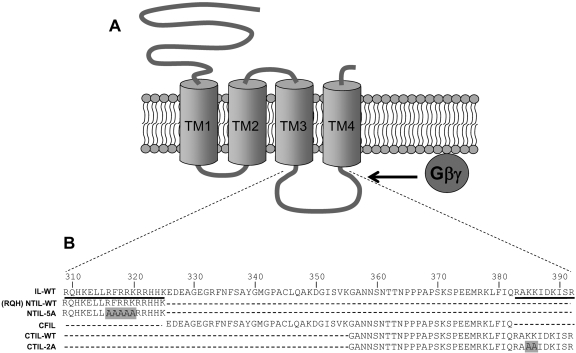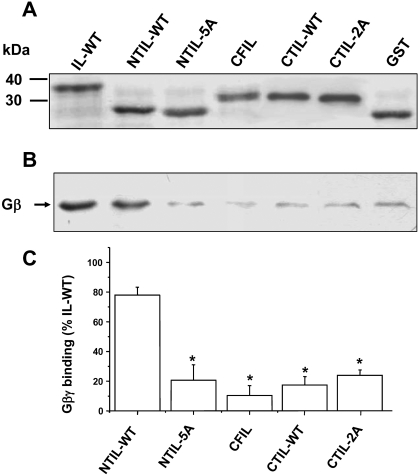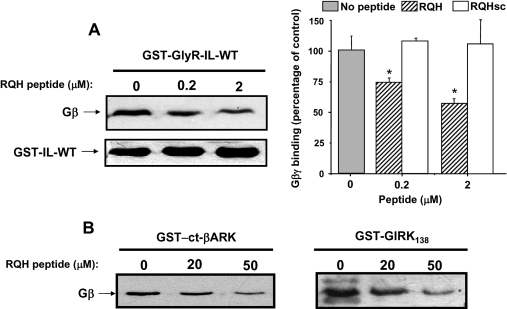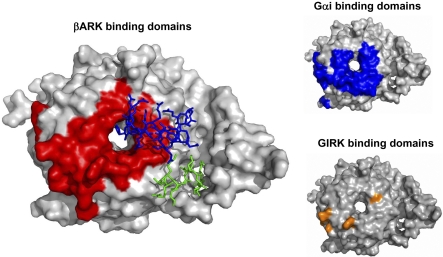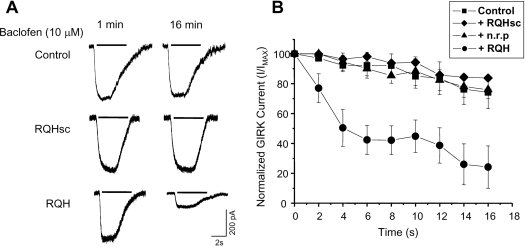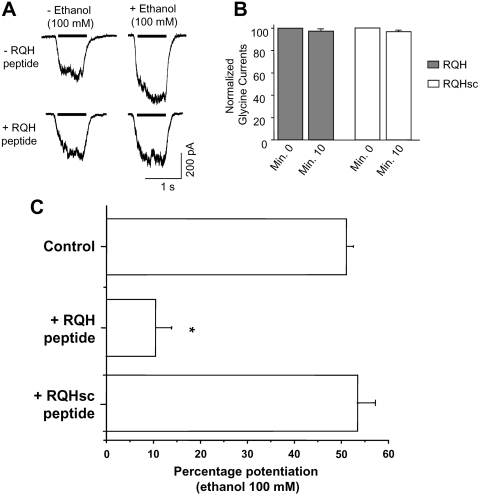Abstract
The large intracellular loop (IL) of the glycine receptor (GlyR) interacts with various signaling proteins and plays a fundamental role in trafficking and regulation of several receptor properties, including a direct interaction with Gβγ. In the present study, we found that mutation of basic residues in the N-terminal region of the IL reduced the binding of Gβγ to 21 ± 10% of control. Two basic residues in the C-terminal region, on the other hand, contributed to a smaller extent to Gβγ binding. Using docking analysis, we found that both basic regions of the IL bind in nearby regions to the Gβγ dimer, within an area of high density of amino acids having an electronegative character. Thereafter, we generated a 17-amino acid peptide with the N-terminal sequence of the wild-type IL (RQH) that was able to inhibit the in vitro binding of Gβγ to GlyRs to 57 ± 5% of control in glutathione S-transferase pull-down assays using purified proteins. More interestingly, when the peptide was intracellularly applied to human embryonic kidney 293 cells, it inhibited the Gβγ-mediated modulations of G protein-coupled inwardly rectifying potassium channel by baclofen (24 ± 14% of control) and attenuated the GlyR potentiation by ethanol (51 ± 10% versus 10 ± 3%).
The glycine receptor (GlyR) is a member of the ligand-gated ion channel (LGIC) superfamily, and along with acetylcholine nicotinic receptors, serotonin receptors, and γ-aminobutyric acid (GABA)A receptors, GlyR conforms the Cys-loop family. Its activation by glycine causes a rapid increase in Cl− conductance, resulting in postsynaptic membrane hyperpolarization and leading to an effective inhibitory response. GlyRs are the main inhibitory LGICs in spinal cord and brain stem (Legendre, 2001), thus explaining their role in pain transmission, motor control, and cardiovascular and respiratory regulations. GlyRs are composed of α1 through α4 and β subunits, which are arranged as pentamers with all the ion-permeating function residing in the α subunits (Moss and Smart, 2001). The receptor can assemble as a functional membrane protein only with the combination of α1 subunits, making the examination of molecular determinants for receptor activation, blocking, and modulation straightforward (Legendre, 2001). Each of the receptor subunits presents a large extracellular amino terminal domain, four transmembrane α helixes (TM1–4), and a large intracellular loop (IL) between TM3 and TM4. The IL is relevant for GlyR function because it was reported that it can be modulated by activation of intracellular cAMP-dependent protein kinase and protein kinase C (Aguayo et al., 1996; Tapia et al., 1997). GlyR modulation and the direct interaction with specific intracellular domains in the receptor have been recently documented (Yevenes et al., 2003, 2006). Furthermore, recent studies showed that, similar to nicotinic acetylcholine receptor (Fischer et al., 2005), the GlyR function can be directly modulated by Gβγ. Together, these results clearly link this inhibitory receptor to specific intracellular signal transduction pathways.
Although it is recognized that taurine, β-alanine, Zn2+, neurosteroids, picrotoxin, and strychnine are important ligands acting on GlyR, their mechanism and sites of action are not well understood (Young and Snyder, 1974; Prince and Simmonds, 1992; Laube et al., 1995; Wu et al., 1997). Furthermore, previous studies have described that the function of GlyRs was enhanced by pharmacological relevant concentrations of ethanol (≤100 mM). Supporting the idea that the effects of ethanol are partly mediated by signal transduction, ethanol actions on spinal GlyRs are modulated by the presence of guanine nucleotides and regulators of G protein activation (Aguayo and Pancetti, 1994; Aguayo et al., 1996; Tapia et al., 1997). Moreover, recent findings from our laboratory showed that Gβγ is a main factor for potentiation of the GlyR by low concentrations of ethanol (Yevenes et al., 2008).
Although there is not a well defined consensus sequence within the several proteins that interact with Gβγ, the presence of basic amino acids (Arg, Lys) appears to be essential (Krapivinsky et al., 1998; Cantí et al., 1999). In the case of GlyRs, mutations in basic amino acids in the IL decreased both the interaction and modulation of Gβγ with GlyRs (Yevenes et al., 2006). Therefore, using biochemical, electrophysiological, and in silico techniques, we decided to examine the ability of several regions of the α1 GlyR IL to directly interfere with Gβγ signaling. We identified a heptadecapeptide with the sequence of the N-terminal region of the IL that was able to inhibit the effects of Gβγ on two effectors, GABAB activation of G protein-coupled inwardly rectifying potassium channel (GIRK) and, more interestingly, the ethanol-induced potentiation of GlyRs.
Materials and Methods
Plasmids and Constructions.
All the chemicals and reagents were purchased from Sigma-Aldrich (St. Louis, MO), and the molecular biology reagents were from New England Biolabs (Ipswich, MA) unless otherwise indicated. Expression vectors for GABAB1 and GABAB2 were provided by Dr. Andres Couve (University of Chile, Santiago, Chile). The GIRK1 plasmid was used as the template for glutathione S-transferase (GST) fusion protein construction using polymerase chain reaction products designed for the insertion in the pGEX-5×3 vector (GE Healthcare, Little Chalfont, Buckinghamshire, UK). The plasmid encoding β-adrenergic receptor kinase [βARK; G protein-coupled receptor kinase (GRK2)], GIRK1, and GIRK4 were provided by Dr. Stephen Ikeda (National Institutes of Health, Bethesda, MD). The heptadecapeptide RQH (RQHKELLRFRRKRRHHK) and its scrambled analog RQHsc (REKHRLKHRFKHRLRQR) were purchased from GenScript Corporation (Piscataway, NJ).
Molecular Modeling and Docking.
The secondary structure of IL fragments was obtained from the SCRATCH web page (http://www.igb.uci.edu/tools/scratch) (Cheng et al., 2005), three-dimensionally modeled with Pymol (http://pymol.sourceforge.net), and energetically minimized in GROMACS (http://www.gromacs.org/) (Van Der Spoel et al., 2005) with a molecular dynamic of 1 ns in the Gromos96 43bl power field. The following fragments of the IL were used: N-terminal [(NTIL)-wild type (WT), from Arg309 to Lys392], C-terminal (CTIL-WT, from Arg382 to Arg392), and their mutant versions (NTIL-5A, 316-320A and CTIL-2A, 385-386A). For Gβγ (Protein Data Bank 1tbg), molecular docking was performed using ZDOCK software (http://zlab.bu.edu/zdock/index.shtml) in an angular step of 6° (Chen et al., 2003). Two thousand docking results were clustered into 10 groups using CLUSPRO server (http://nrc.bu.edu/cluster/) (Comeau et al., 2004). The structure of the complex representing the main cluster was minimized energetically with a molecular dynamic of 1 ns under the same conditions used for the fragments alone. The free energy calculation was determined with FastContact server (http://structure.pitt.edu/servers/fastcontact/) (Camacho and Zhang, 2005). The surface electrostatic potential was calculated with APBS software (http://apbs.sourceforge.net/) (Baker et al., 2001). All the images were obtained with Pymol software. In the figures, blue and red represent regions of positive or negative electrostatic potential, respectively.
Construction of GST Fusion Proteins and GST Pull-Down Assays.
DNA fragments encoding WT and mutant IL fragments, βARK C terminus, and GIRK1 (amino acids 184–501) were subcloned in the vector pGEX-5×3 (GE Healthcare). GST fusion proteins were expressed in Escherichia coli BL21 bacteria using 50 μM isopropyl β-d-1-thiogalactopyranoside. After 4 h, the cells were collected and sonicated in lysis buffer (phosphate buffer, 1% Triton X-100, protease inhibitor mixture II; Calbiochem, San Diego, CA). Subsequently, the proteins were purified using a glutathione resin (Novagen, Madison, WI)). Normalized amounts of GST fusion protein were incubated with purified Gβγ protein (10 ng; Calbiochem). Incubations were done in 800 μl of binding buffer (200 mM NaCl, 10 mM EDTA, 10 mM Tris, pH 7.4, 0.1% Triton X-100, and protease inhibitor mixture II) at 4°C for 1 h. The beads were washed five times in binding buffer, and bound proteins were separated on 12% SDS-polyacrylamide gels. Bound Gβγ was detected using an anti-Gβ antibody (1:1000; Santa Cruz Biotechnology, Inc., Santa Cruz, CA) and a chemiluminescence kit (PerkinElmer Life and Analytical Sciences, Waltham, MA). The complete IL in fusion with GST and GST alone were used as positive and negative controls, respectively. Finally, the relative amount of Gβγ was quantified by densitometry. Gβ detection on Western blots was considered direct evidence for Gβγ binding.
Electrophysiology.
For experiments with GIRK channels, human embryonic kidney (HEK) 293 cells were cultured using standard methodologies and cotransfected with plasmids encoding the GABAB receptor subunits GABAB1 (fused to green fluorescent protein), GABAB2, GIRK1, and GIRK4 using Lipofectamine 2000 (Invitrogen, Carlsbad, CA). Expression of green fluorescent protein was used as a marker for positively transfected cells, and recordings were made after 18 to 24 h. Whole-cell recordings were performed using a holding potential of −60 mV. Patch electrodes were filled with 120 mM KCl, 10 mM 1,2-bis(o-aminophenoxy)ethane-N,N,N′,N′-tetraacetic acid, 10 mM HEPES, pH 7.4, 4 mM MgCl2, 2 mM ATP, and 0.5 mM GTP with or without 200 μM RQH peptide. The external solution contained 125 mM NaCl, 30.0 mM KCl, 3.0 mM CaCl2, 1.0 mM MgCl2, 10 mM HEPES, pH 7.4, and 10 mM glucose. The amplitude of the potassium current was measured using a short pulse (4–5 s) of 10 μM baclofen every 2 min during 16 min. A nonrelated peptide (EVHHQKL) was used as a control at the same concentration. We used this small peptide to bolster the capacity to access the intracellular milieu and to interact with Gβγ. For the recording of ethanol-mediated potentiation on GlyRs, a previously described methodology was used (Yevenes et al., 2003, 2006). Ethanol was coapplied with glycine (15 μM), and the results were expressed as percentage of potentiation at 15 min. Although ethanol effects on GlyRs are apparent with 10 mM (Aguayo et al., 1996; Yevenes et al., 2008), we decided to use 100 mM to increase the noise to signal ratio, facilitating the statistical analysis and comparison with previous work from our and other laboratories. A scrambled peptide with the same amino acid composition (previously described) was used as control.
Data Analysis.
Statistical analyses were performed using analysis of variance, and the results are expressed as the arithmetic mean ± S.E.M. Values of P < 0.05 were considered statistically significant. Origin 7.0 (OriginLab Corp., Northampton, MA) software was used for all the statistical analyses.
Results
Binding of Gβγ to IL Fragments.
It has been previously established that the GlyR IL (between TM3 and TM4) plays an important role in channel modulation through its interactions with signal transduction proteins (Smart, 1997; Yevenes et al., 2006). For example, it was found that GTPγS enhances the glycinergic current and that this effect was blocked by the expression of Gβγ scavengers, such as ct-βARK (Pitcher et al., 1992). This result supports single-channel recordings that showed an increased open channel probability in the presence of Gβγ (Yevenes et al., 2003). A more recent study indicated that truncation of the central region of the IL (Glu326–Gln382) did not affect the regulation by Gβγ (Yevenes et al., 2006). However, mutations in the clusters of basic residues in the IL (Arg316 to Lys320, Lys385, and Lys 386) attenuated the potentiation caused by Gβγ. Therefore, to examine the contributions of these two motifs in the interaction with Gβγ, we constructed GST fusion proteins in wild and mutant forms and studied their ability to directly bind Gβγ using GST pull-down assays. Figure 1 shows a scheme with the different regions of the IL used for construction of GST fusion proteins.
Fig. 1.
Scheme of the GlyR topology and the sequences of recombinant fragments. A, schematic topology of the human α1 GlyR subunit. B, alignment of intracellular fragments used for GST pull-down assays and molecular docking. Underlined are the sequences used for molecular modeling and docking. IL-WT, full α1 IL; NTIL-WT, N-terminal (17 amino acids) region of IL; NTIL-5A, mutant version with alanine substitutions; CFIL, central fragment (326–381) of IL; CTIL-WT, C-terminal region of IL; CTIL-2A, mutant version. The sequence of NTIL-WT served as template for the RQH peptide.
Figure 2A illustrates purified fusion proteins that were visualized in a brilliant blue-stained SDS-acrylamide gel. The binding of Gβγ dimer to these proteins was subsequently analyzed with Western blot (Fig. 2B, see the experimental procedures for details). The data show that the NTIL is sufficient to display a significant Gβγ dimer binding (78 ± 5% of control) and that this binding was strongly diminished (21 ± 12%) by mutating the positive residue cluster (from position 316 to 320) to alanine. Moreover, the data show that Gβγ was unable to bind the central fragment of the IL (Fig. 2, B and C). These results support previous studies showing that direct binding of Gβγ to the GlyR and its subsequent channel modulation were diminished by mutations in basic residues (Yevenes et al., 2006). On the other hand, the C-terminal region (CTIL-WT) in fusion with GST did not present a significant binding to Gβγ in the pull-down assays (Fig. 2C). In a previous study, using the entire loop, we reported that this region contributed to Gβγ binding (Yevenes et al., 2006). With these in vitro results, it was evident that the N-terminal region was comparatively more important for Gβγ binding than the central or the C-terminal regions of the IL.
Fig. 2.
Binding of Gβγ to different GlyR IL regions. A, brilliant blue staining of purified GST fusion proteins. B, binding of Gβγ to IL-WT and fragments detected as Western blots from GST pull-down experiments. C, quantification of Gβγ binding to different intracellular fragments. The bars represent the mean ± S.E.M. obtained from at least three different experiments. The level of Gβγ binding to NTIL-WT was significantly different (*, P < 0.05).
We then used computational modeling to obtain theoretical information about the contribution of these two GlyR IL regions (Fig. 1) for the binding of Gβγ (Fig. 3). According to secondary structure prediction, both IL regions were modeled as α helices. By using this technique, we found that both fragments fit in nearby regions of the Gβγ dimer, within an area of Gβγ that has a high density of amino acids with an electronegative character (as shown in red). The values for ΔG calculated in the in silico analysis showed that the N-terminal region of the IL binds to Gβγ with a higher strength than the C-terminal region, with values of −20.63 and −12.15 kcal/mol, respectively. In addition, the docking studies with the alanine-substituted IL fragments to Gβγ showed large reductions in ΔG values (−1.44 and −12.00 kcal/mol for N- and C-terminal regions, respectively). These results support the conclusion that the N-terminal region is very relevant for Gβγ binding, and it could be an area of choice for the design of a Gβγ-blocking peptide.
Fig. 3.
Molecular docking of N- and C-terminal fragments to Gβγ. Molecular docking was performed using crystallographic three-dimensional data of Gβγ (blue and red represent regions of positive and negative electrostatic potential, respectively) as described under Materials and Methods. A, WT N- and C-terminal fragments (Arg309–Lys325 and Arg382–Arg392) interact with high ΔG binding in different regions on the highly electronegative surface of Gβγ. B, mutant N- and C-terminal fragments [316-320A (5A) and 385-386A (2A)] interact with Gβγ with a reduced ΔG binding (see text).
Peptide Derived from the GlyR IL N-Terminal Region Sequence Interfered with Gβγ Binding to Several Effectors.
We synthesized a small peptide, referred to as RQH (see Fig. 1), to test its capacity to interfere with the binding of the IL to Gβγ and with activation of some effectors. Micromolar concentrations (0.2 and 2 μM) of this peptide were able to inhibit the binding of Gβγ to the whole IL of the GlyR in GST pull-down assays to 74 ± 4 and 57 ± 5%, respectively, compared with control (Fig. 4A). No higher level of binding inhibition was found with 20 μM RQH. However, showing the specificity of the peptide inhibition, we found that the same concentrations of the scramble peptide were unable to alter the binding of Gβγ to the IL (Fig. 4A). Moreover, the RQH peptide was able to interfere with the binding of Gβγ to two other effectors coupled to GST, such as GST-ct-βARK and GST-GIRK138. Comparison of the predicted binding position of RQH in Gβγ crystal structure indicated that the regions for binding of RQH, βARK, and GIRK1 are partly overlapped (Fig. 5). These data are in agreement with previous crystallographic studies of Gβγ in complex with ct-βARK and Gαi, as well as mutational analysis of GIRK (Ford et al., 1998; Li et al., 1998). A similar conclusion was reached comparing regions of binding for GIRK1 (Ford et al., 1998) and the RQH peptide on Gβγ (Fig. 5).
Fig. 4.
RQH reduced Gβγ binding to GlyR and other dimer effectors. A, binding of Gβγ to the full IL (GST-IL-WT) was reduced by RQH. The graph shows the quantification of Gβγ binding to GST-IL-WT in the presence of RQH (dashed bars) or a scrambled peptide (RQHsc, white bars). Data are from four different GST pull-down experiments that were quantified and plotted as percentage of control condition, without any peptide (gray bar) (*, P < 0.05 compared with control). B, reduction of Gβγ binding to ct-βARK and GIRK1138 by RQH at the shown micromolar concentrations. Similar results were obtained in three different experiments.
Fig. 5.
GlyR-IL shares binding domains with other effectors in Gβγ. The model shows Gβγ binding domains for βARK, Gαi, and GIRK (red, blue, and yellow, respectively). These regions partly overlap those of the N- and C-terminal in the GlyR IL (blue and green, respectively). The structural data for Gβγ, ct-βARK, and Gαi were indicated under Materials and Methods. The GIRK binding domains were taken from mutational studies (Ford et al., 1998).
RQH Blocks Gβγ-Mediated Activation of GIRK and Ethanol Potentiation of GlyR Channels.
Based on the results obtained with RQH, we wanted to find out whether this peptide could interfere with the Gβγ-mediated modulation of two different cellular effectors. Therefore, we added this short peptide in the intracellular solution using the patch-clamp technique and tested two Gβγ-mediated effects. First, HEK cells were cotransfected with the GABAB receptor and GIRK1–4 to assemble a K+-permeable ion channel (Jones et al., 1998; Kaupmann et al., 1998; White et al., 1998). Under these conditions, the stimulation of GABAB receptors with 10 μM baclofen induced a K+ current that was well sustained in time. It is interesting to note that intracellular dialysis with RQH (200 μM) in the patch pipette significantly inhibited the potassium current activated by Gβγ to 24 ± 14% of the control response (Fig. 6). On the other hand, neither a scrambled peptide (RQHsc) nor a nonrelated peptide affected the baclofen-activated K+ current. Second, it was previously reported that GlyR potentiation by ethanol was dependent on the state of activation of the G protein (Aguayo et al., 1996; Yevenes et al., 2008). Therefore, we tested the sensitivity of the α1 GlyR subunit to ethanol in the presence of the peptide in the intracellular solution. For this, the glycine-induced current was measured with and without ethanol perfusion after 10 min of RQH peptide intracellular dialysis. The data showed that HEK cells expressing GlyRs were potentiated with ethanol by 51 ± 10% over control, and that this enhancement was significantly inhibited by RQH (Fig. 7, A and C). The ethanol-induced potentiation of GlyRs was not altered when the cells were dialyzed with the scrambled peptide (RQHsc). Likewise, although the receptor became insensitive to ethanol, the current properties, such as amplitude and time course, were unchanged by 10 min of dialysis with RQH indicating that the peptide had no effects on basal GlyR function (Fig. 7, A and B).
Fig. 6.
RQH peptide interferes with Gβγ-mediated activation of GIRK. A, data show the effect of RQH on activation of GIRK (GIRK1 and GIRK4) by GABAB receptors (R1 and R2) in HEK 293 cells. The baclofen-induced K+ current was inhibited by intracellular application of RQH, but not the scrambled peptide, in the patch pipette. B, time course of baclofen-stimulated K+ current in the absence (squares) and presence of RQH (circles), RQHsc (diamonds), and a nonrelated peptide (triangles). All the peptides were used at a concentration of 200 μM. The symbols represent the mean ± S.E.M. from more than six cells.
Fig. 7.
RQH interferes with the ethanol-induced potentiation of the GlyR. A, the current traces were evoked activating α1 containing GlyRs with 15 μM glycine in the absence and presence of ethanol (100 mM). The lower traces were recorded after 10 min of intracellular dialysis with RQH peptide (200 μM) in the patch pipette. B, graph shows the normalized glycine current amplitude after 10 min of intracellular dialysis with either RQH or RQHsc peptides. C, graph summarizes the percentage potentiation elicited by 100 mM ethanol in the absence and presence of RQH or scrambled peptides (RQHsc) intracellularly applied for 10 min. The symbols represent the mean ± S.E.M. from at least six cells. *, represents a difference from control, P < 0.05.
Discussion
Gβγ dimer release after heterotrimeric G protein activation can control diverse physiological processes, such as heart rate, hormonal and neurotransmitter release, neuronal excitability, and cell migration. These actions are mediated by the direct interaction between Gβγ and its effectors that range from membrane channels that control excitability to soluble enzymes that have metabolic or signaling functions (Clapham and Neer, 1997; Hamm, 1998). In an effort to identify sequences useful to interfere with Gβγ-mediated signaling, the QEHA peptide (from adenylyl cyclase 2) was generated (Chen et al., 1995). However, it was found that several Gβγ effectors lack this type of motif, making its use limited (Touhara et al., 1995; Barr et al., 2000; Davis et al., 2005). Even in the absence of a defined molecular motif for Gβγ binding, several studies have shown that basic amino acids have important roles on binding and modulation of effectors, such as βARK, GIRK, voltage-dependent calcium channels, and phospholipase C (Koch et al., 1993; Touhara et al., 1994; Krapivinsky et al., 1998; Cantí et al., 1999; Barr et al., 2000). More recently, it has been shown that the GlyR contains two basic motifs in its IL that are responsible for Gβγ modulation (Yevenes et al., 2003, 2006). In the present study, we examined these motifs using three approaches: 1) in vitro binding studies with GST pull down, 2) modeling/docking in silico calculations, and 3) functional assays of Gβγ-modulated ion channels to obtain a sequence for the design of a small peptide with the capacity to block the action of Gβγ. In agreement with other previous studies, we found that the N-terminal motif of the IL exerted an important role for Gβγ binding. The central region, on the other hand, was unable to bind Gβγ, which agrees with functional studies (Yevenes et al., 2006). Surprisingly, we did not detect significant Gβγ binding to the C-terminal region, a finding which contrasts with a proposed role of this motif in functional modulation (Yevenes et al., 2006). However, it is possible that expression of the fusion protein altered the secondary structure of the C-terminal region. These results were well supported by the docking analyses that revealed a higher ΔG for binding of the N-terminal region compared with the C-terminal region of the GlyR IL and confirmed previous results (Yevenes et al., 2006), indicating that the N-terminal region is very important for the direct binding of Gβγ. The C-terminal motif, on the other hand, presents a smaller Gβγ binding capacity, but it might be important for the conformational changes controlling channel gating (Yevenes et al., 2008).
Based on these results and to try to interfere with Gβγ-mediated modulation, we designed a mini-peptide with the first 17 amino acids of the IL (RQH peptide). As expected, the peptide produced an inhibition of the binding of Gβγ to the entire IL of GlyR using an in vitro interaction assay. In addition, we found that the binding of ct-βARK and GIRK1 to Gβγ in the GST assay was also reduced by the peptide, in agreement with the existence of somewhat overlapping regions with distinct effectors (Ford et al., 1998). Finally, functional assays showed that the RQH peptide affected two Gβγ-linked responses: activation of GIRK by GABAB receptor and potentiation of α1 GlyR by ethanol (Kaupmann et al., 1998; Yevenes et al., 2003). The data support the conclusion that these inhibitions were produced by binding of the RQH peptide to effector recognition regions in Gβγ. Accordingly, the RQH peptide appears to behave as a scavenger as we showed that it can interact and block the effects of Gβγ in two effectors (GlyR and GIRK). RQH did not have any apparent effects on GlyR properties and function, suggesting that previous release of Gβγ is necessary to exert its blocking action. Furthermore, although the data cannot exclude the possibility that RQH affects the binding of Gβγ to Gα subunits, we believe that it is unlikely that it would activate G proteins and subsequently block the Gβγ dimer. In conclusion, the newly identified RQH was able to inhibit the binding of several effectors to Gβγ and ethanol potentiation, without noticeable changes on the properties of the GlyR or general cell function, opening new possibilities to design small molecules that interfere with signal transduction.
In relevance to alcohol abuse, it is now accepted that GlyRs are a major target for the intoxicating effects of ethanol as suggested by previous studies from our and other groups (Aguayo et al., 1996; Findlay et al., 2002; Molander et al., 2005, 2007). Therefore, the present results are relevant because we show that a small heptadecapeptide can antagonize the alcohol effect on an LGIC, opening new possibilities for the study of small organic molecules that can interfere with the intoxicating effect of ethanol, which supports previous work in relation to the development of compounds that can affect G protein activity (Davis et al., 2005; Bonacci et al., 2006).
Acknowledgments
We thank Laurie Aguayo for technical assistance in molecular biology and text editing and Pablo Lara for helping with some preliminary experiments.
This work was supported in part by the National Institutes of Health National Institute on Alcohol Abuse and Alcoholism [Grant AA15150]; Fondo Nacional de Desarrollo Cientifico y Tecnologico [Grant 11080145]; and CONICYT Bicentenario [Grant 7].
Article, publication date, and citation information can be found at http://jpet.aspetjournals.org.
doi:10.1124/jpet.109.160440
- GlyR
- glycine receptor
- LGIC
- ligand-gated ion channels
- GABA
- γ-aminobutyric acid
- TM
- transmembrane
- IL
- intracellular loop
- GIRK
- G protein-coupled inwardly rectifying potassium channel
- GST
- glutathione S-transferase
- βARK
- β-adrenergic receptor kinase
- GRK
- G protein-coupled receptor kinase
- NTIL
- N-terminal intracellular loop
- WT
- wild type
- CTIL
- C-terminal intracellular loop
- HEK
- human embryonic kidney
- ct
- C-terminal.
References
- Aguayo LG, Pancetti FC. (1994) Ethanol modulation of the gamma-aminobutyric acidA- and glycine-activated Cl- current in cultured mouse neurons. J Pharmacol Exp Ther 270:61–69 [PubMed] [Google Scholar]
- Aguayo LG, Tapia JC, Pancetti FC. (1996) Potentiation of the glycine-activated Cl- current by ethanol in cultured mouse spinal neurons. J Pharmacol Exp Ther 279:1116–1122 [PubMed] [Google Scholar]
- Baker NA, Sept D, Joseph S, Holst MJ, McCammon JA. (2001) Electrostatics of nanosystems: application to microtubules and the ribosome. Proc Natl Acad Sci U S A 98:10037–10041 [DOI] [PMC free article] [PubMed] [Google Scholar]
- Barr AJ, Ali H, Haribabu B, Snyderman R, Smrcka AV. (2000) Identification of a region at the N-terminus of phospholipase C-beta 3 that interacts with G protein beta gamma subunits. Biochemistry 39:1800–1806 [DOI] [PubMed] [Google Scholar]
- Bonacci TM, Mathews JL, Yuan C, Lehmann DM, Malik S, Wu D, Font JL, Bidlack JM, Smrcka AV. (2006) Differential targeting of Gbetagamma-subunit signaling with small molecules. Science 312:443–446 [DOI] [PubMed] [Google Scholar]
- Camacho CJ, Zhang C. (2005) FastContact: rapid estimate of contact and binding free energies. Bioinformatics 21:2534–2536 [DOI] [PubMed] [Google Scholar]
- Cantí C, Page KM, Stephens GJ, Dolphin AC. (1999) Identification of residues in the N terminus of alpha1B critical for inhibition of the voltage-dependent calcium channel by Gbeta gamma. J Neurosci 19:6855–6864 [DOI] [PMC free article] [PubMed] [Google Scholar]
- Chen J, DeVivo M, Dingus J, Harry A, Li J, Sui J, Carty DJ, Blank JL, Exton JH, Stoffel RH. (1995) A region of adenylyl cyclase 2 critical for regulation by G protein beta gamma subunits. Science 268:1166–1169 [DOI] [PubMed] [Google Scholar]
- Chen R, Li L, Weng Z. (2003) ZDOCK: an initial-stage protein-docking algorithm. Proteins 52:80–87 [DOI] [PubMed] [Google Scholar]
- Cheng J, Randall AZ, Sweredoski MJ, Baldi P. (2005) SCRATCH: a protein structure and structural feature prediction server. Nucleic Acids Res 33:W72–W76 [DOI] [PMC free article] [PubMed] [Google Scholar]
- Clapham DE, Neer EJ. (1997) G protein beta gamma subunits. Annu Rev Pharmacol Toxicol 37:167–203 [DOI] [PubMed] [Google Scholar]
- Comeau SR, Gatchell DW, Vajda S, Camacho CJ. (2004) ClusPro: an automated docking and discrimination method for the prediction of protein complexes. Bioinformatics 20:45–50 [DOI] [PubMed] [Google Scholar]
- Davis TL, Bonacci TM, Sprang SR, Smrcka AV. (2005) Structural and molecular characterization of a preferred protein interaction surface on G protein beta gamma subunits. Biochemistry 44:10593–10604 [DOI] [PubMed] [Google Scholar]
- Findlay GS, Wick MJ, Mascia MP, Wallace D, Miller GW, Harris RA, Blednov YA. (2002) Transgenic expression of a mutant glycine receptor decreases alcohol sensitivity of mice. J Pharmacol Exp Ther 300:526–534 [DOI] [PubMed] [Google Scholar]
- Fischer H, Liu DM, Lee A, Harries JC, Adams DJ. (2005) Selective modulation of neuronal nicotinic acetylcholine receptor channel subunits by Go-protein subunits. J Neurosci 25:3571–3577 [DOI] [PMC free article] [PubMed] [Google Scholar]
- Ford CE, Skiba NP, Bae H, Daaka Y, Reuveny E, Shekter LR, Rosal R, Weng G, Yang CS, Iyengar R, et al. ( 1998) Molecular basis for interactions of G protein betagamma subunits with effectors. Science 280:1271–1274 [DOI] [PubMed] [Google Scholar]
- Hamm HE. (1998) The many faces of G protein signaling. J Biol Chem 273:669–672 [DOI] [PubMed] [Google Scholar]
- Jones KA, Borowsky B, Tamm JA, Craig DA, Durkin MM, Dai M, Yao WJ, Johnson M, Gunwaldsen C, Huang LY, et al. ( 1998) GABA(B) receptors function as a heteromeric assembly of the subunits GABA(B)R1 and GABA(B)R2. Nature 396:674–679 [DOI] [PubMed] [Google Scholar]
- Kaupmann K, Malitschek B, Schuler V, Heid J, Froestl W, Beck P, Mosbacher J, Bischoff S, Kulik A, Shigemoto R, et al. ( 1998) GABA(B)-receptor subtypes assemble into functional heteromeric complexes. Nature 396:683–687 [DOI] [PubMed] [Google Scholar]
- Koch WJ, Inglese J, Stone WC, Lefkowitz RJ. (1993) The binding site for the beta gamma subunits of heterotrimeric G proteins on the beta-adrenergic receptor kinase. J Biol Chem 268:8256–8260 [PubMed] [Google Scholar]
- Krapivinsky G, Kennedy ME, Nemec J, Medina I, Krapivinsky L, Clapham DE. (1998) Gbeta binding to GIRK4 subunit is critical for G protein-gated K+ channel activation. J Biol Chem 273:16946–16952 [DOI] [PubMed] [Google Scholar]
- Laube B, Kuhse J, Rundström N, Kirsch J, Schmieden V, Betz H. (1995) Modulation by zinc ions of native rat and recombinant human inhibitory glycine receptors. J Physiol 483:613–619 [DOI] [PMC free article] [PubMed] [Google Scholar]
- Legendre P. (2001) The glycinergic inhibitory synapse. Cell Mol Life Sci 58:760–793 [DOI] [PMC free article] [PubMed] [Google Scholar]
- Li Y, Sternweis PM, Charnecki S, Smith TF, Gilman AG, Neer EJ, Kozasa T. (1998) Sites for Galpha binding on the G protein beta subunit overlap with sites for regulation of phospholipase Cbeta and adenylyl cyclase. J Biol Chem 273:16265–16272 [DOI] [PubMed] [Google Scholar]
- Molander A, Lidö HH, Löf E, Ericson M, Söderpalm B. (2007) The glycine reuptake inhibitor Org 25935 decreases ethanol intake and preference in male Wistar rats. Alcohol Alcohol 42:11–18 [DOI] [PubMed] [Google Scholar]
- Molander A, Löf E, Stomberg R, Ericson M, Söderpalm B. (2005) Involvement of accumbal glycine receptors in the regulation of voluntary ethanol intake in the rat. Alcohol Clin Exp Res 29:38–45 [DOI] [PubMed] [Google Scholar]
- Moss SJ, Smart TG. (2001) Constructing inhibitory synapses. Nat Rev Neurosci 2:240–250 [DOI] [PubMed] [Google Scholar]
- Pitcher JA, Inglese J, Higgins JB, Arriza JL, Casey PJ, Kim C, Benovic JL, Kwatra MM, Caron MG, Lefkowitz RJ. (1992) Role of beta gamma subunits of G proteins in targeting the beta-adrenergic receptor kinase to membrane-bound receptors. Science 257:1264–1267 [DOI] [PubMed] [Google Scholar]
- Prince RJ, Simmonds MA. (1992) Steroid modulation of the strychnine-sensitive glycine receptor. Neuropharmacology 31:201–205 [DOI] [PubMed] [Google Scholar]
- Smart TG. (1997) Regulation of excitatory and inhibitory neurotransmitter-gated ion channels by protein phosphorylation. Curr Opin Neurobiol 7:358–367 [DOI] [PubMed] [Google Scholar]
- Tapia JC, Espinoza F, Aguayo LG. (1997) Differential intracellular regulation of cortical GABA(A) and spinal glycine receptors in cultured neurons. Brain Res 769:203–210 [DOI] [PubMed] [Google Scholar]
- Touhara K, Inglese J, Pitcher JA, Shaw G, Lefkowitz RJ. (1994) Binding of G protein beta gamma-subunits to pleckstrin homology domains. J Biol Chem 269:10217–10220 [PubMed] [Google Scholar]
- Touhara K, Koch WJ, Hawes BE, Lefkowitz RJ. (1995) Mutational analysis of the pleckstrin homology domain of the beta-adrenergic receptor kinase. Differential effects on G beta gamma and phosphatidylinositol 4,5-bisphosphate binding. J Biol Chem 270:17000–17005 [DOI] [PubMed] [Google Scholar]
- Van Der Spoel D, Lindahl E, Hess B, Groenhof G, Mark AE, Berendsen HJ. (2005) GROMACS: fast, flexible, and free. J Comput Chem 26:1701–1718 [DOI] [PubMed] [Google Scholar]
- White JH, Wise A, Main MJ, Green A, Fraser NJ, Disney GH, Barnes AA, Emson P, Foord SM, Marshall FH. (1998) Heterodimerization is required for the formation of a functional GABA(B) receptor. Nature 396:679–682 [DOI] [PubMed] [Google Scholar]
- Wu FS, Chen SC, Tsai JJ. (1997) Competitive inhibition of the glycine-induced current by pregnenolone sulfate in cultured chick spinal cord neurons. Brain Res 750:318–320 [DOI] [PubMed] [Google Scholar]
- Yevenes GE, Moraga-Cid G, Guzmán L, Haeger S, Oliveira L, Olate J, Schmalzing G, Aguayo LG. (2006) Molecular determinants for G protein betagamma modulation of ionotropic glycine receptors. J Biol Chem 281:39300–39307 [DOI] [PubMed] [Google Scholar]
- Yevenes GE, Moraga-Cid G, Peoples RW, Schmalzing G, Aguayo LG. (2008) A selective Gβγ-linked intracellular mechanism for modulation of a ligand-gated ion channel by ethanol. Proc Natl Acad Sci U S A 105:20523–20528 [DOI] [PMC free article] [PubMed] [Google Scholar]
- Yevenes GE, Peoples RW, Tapia JC, Parodi J, Soto X, Olate J, Aguayo LG. (2003) Modulation of glycine-activated ion channel function by G-protein betagamma subunits. Nat Neurosci 6:819–824 [DOI] [PubMed] [Google Scholar]
- Young AB, Snyder SH. (1974) The glycine synaptic receptor: evidence that strychnine binding is associated with the ionic conductance mechanism. Proc Natl Acad Sci U S A 71:4002–4005 [DOI] [PMC free article] [PubMed] [Google Scholar]



